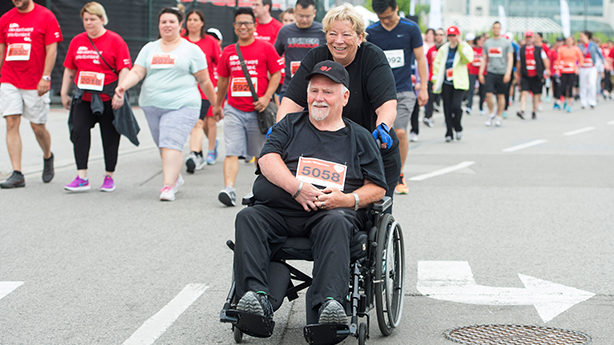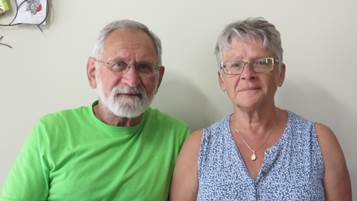Since he had a stroke in 2016, Chuck Ley has overcome many obstacles alongside his wife, Lorraine Joynt. He has regained the ability to walk short distances, and uses a wheelchair for longer outings with Lorraine.
When Chuck was having trouble with ulcers on his leg this year, his family doctor provided phone consultations to help the couple manage them, eventually adding regular home visits by a nurse. The combination is working well, Lorraine says. “Chuck is getting excellent care.”
Meanwhile Lorraine was recovering from knee surgery. When the pandemic put an end to her physiotherapy sessions, a phone appointment with her surgeon helped Lorraine get started on rehabilitation exercises at home.
Chuck and Lorraine are among countless people in Canada who have used a phone or video call to consult their healthcare providers this year. You probably have too.

Virtual appointments have helped Chuck Ley and Lorraine Joynt, pictured at Ride for Heart.
Virtual healthcare is not new, but the COVID-19 pandemic accelerated its use. So what have we learned, and where do we go from here?
Heart & Stroke has pulled together a group of experts to lead this urgent conversation. They are developing policies and tools to improve virtual care and to empower both healthcare professionals and patients.
One of those experts is Dr. Inderveer Mahal, a family doctor in Vancouver. She shared these insights about the ways virtual care has already changed our lives — and what lies ahead.
1. Virtual care can make your life easier.
“Once we got through the logistical workflow and the challenges with selecting the right technology, virtual care has actually been a very positive experience,” Dr. Mahal says of her own practice during the pandemic. “The vast majority of my patients, from young teenagers to the elderly, really like it.”
For one thing, they save the time, effort and cost of getting to the doctor’s office. For example, says Dr. Mahal, “Young parents who have two or three kids may not need to pull them all out of school, or find a babysitter, or take time off work.”
More advantages:
- For people who have disabilities or are frail, a phone or video call can be easier and safer than getting to the doctor’s office.
- A virtual appointment can easily include a family member or caregiver who may be in a different place.
- Patients can experience less waiting time and some healthcare providers can fit more appointments into the day.
This increased access is especially helpful for people like Chuck who are living with a stroke or heart condition and may need frequent appointments, Dr. Mahal says.
2. You can still see your doctor in person.
A virtual appointment is not always the best choice. Dr. Mahal says each patient’s needs and circumstances are key factors to help practitioners identify the most appropriate approach.
For example, she would see in-person any patient who needs a comprehensive physical exam, such as someone in the early stages of recovery from a stroke or heart attack. “That’s where we don't want to miss what we call critical pieces of the puzzle.”
There are other times when face-to-face communication is important to convey sensitive information — say, with a new diagnosis of cancer. Dr. Mahal says practitioners also need to consider factors including culture. “For patients where English isn't their first language, or who have a disability, non-verbal communication is really important,” she says.
“We've realized that virtual care is an excellent tool in our toolkit, but it's not a one-size-fits-all,” Dr. Mahal says. “Heart & Stroke’s position statement around virtual care has really emphasized that when you use it correctly, in the right place at the right time, for the right patient, it's just as good if not better than in-person care.”
- See Heart & Stroke’s decision framework to help healthcare professionals determine when a virtual appointment is suitable.
3. It works best if you’re prepared.
Many healthcare providers have worked hard to make sure their patients know what to expect with a virtual appointment. Dr. Mahal’s team offers advance help to get people comfortable with the technology and make sure they have suitable lighting, sound and privacy.
For a routine appointment, Dr. Mahal suggests patients prepare as they would for an office visit, compiling a list of concerns or questions and a list of their medications. She encourages those who need support to add a family member or other caregiver to the call.
- Get Heart & Stroke’s guide to making the most of your virtual appointment.
4. Virtual care can help beat health inequities.
Virtually connecting to the healthcare system opens up new options for increasing access, especially for people in underserved communities. But work is needed to ensure everyone in Canada can benefit.
Dr. Mahal’s practice includes people in Vancouver’s Downtown Eastside, some of whom live in shelters or tents and don’t have phones or laptops, let alone an internet connection.

Virtually connecting opens up new options for increasing access.
Yet virtual access has actually made it easier for some of these patients to get to their appointments, she says. “We’ve had the support of some shelters and the outreach workers, where they have provided the technology and a private and safe space as well.”
In remote and northern regions, including Indigenous communities, the growth of virtual care has the potential to redress health inequities by helping people connect to a range of health services without leaving their communities. But expanded access to broadband internet is critically needed to make this vision a reality.
5. We need to keep working to make virtual care better.
Virtual care has lots of benefits, including reducing healthcare costs. But Dr. Mahal stresses that resources, research and training are needed to continue improving the delivery of virtual care, make sure it is person-centred, safe and culturally appropriate, and make it truly accessible to all people in Canada.
Heart & Stroke is advocating for investment in these areas:
- Technology and infrastructure:
- Increasing access to broadband internet, especially for remote communities
- Increasing access to technology such as tablets and smartphones
- Providing private spaces where people who don’t have technology can attend a virtual appointment
- Training:
- Educating and supporting healthcare professionals to understand and deliver patient-centred virtual care
- Educating and supporting patients and families on how to use virtual care.
- Data collection and research on implementation and outcomes to improve the delivery of virtual care in Canada.
“When it comes to virtual care, I think Heart & Stroke is really at the forefront of pushing high quality policy, guidance and research into virtual practice,” Dr. Mahal says.
“When you're supporting Heart & Stroke, you're not only supporting research into heart disease and stroke medical concerns, you're also supporting innovation in the Canadian healthcare system.”
- Learn how to make the most of your virtual appointment.
- See Heart & Stroke virtual care resources for healthcare providers




